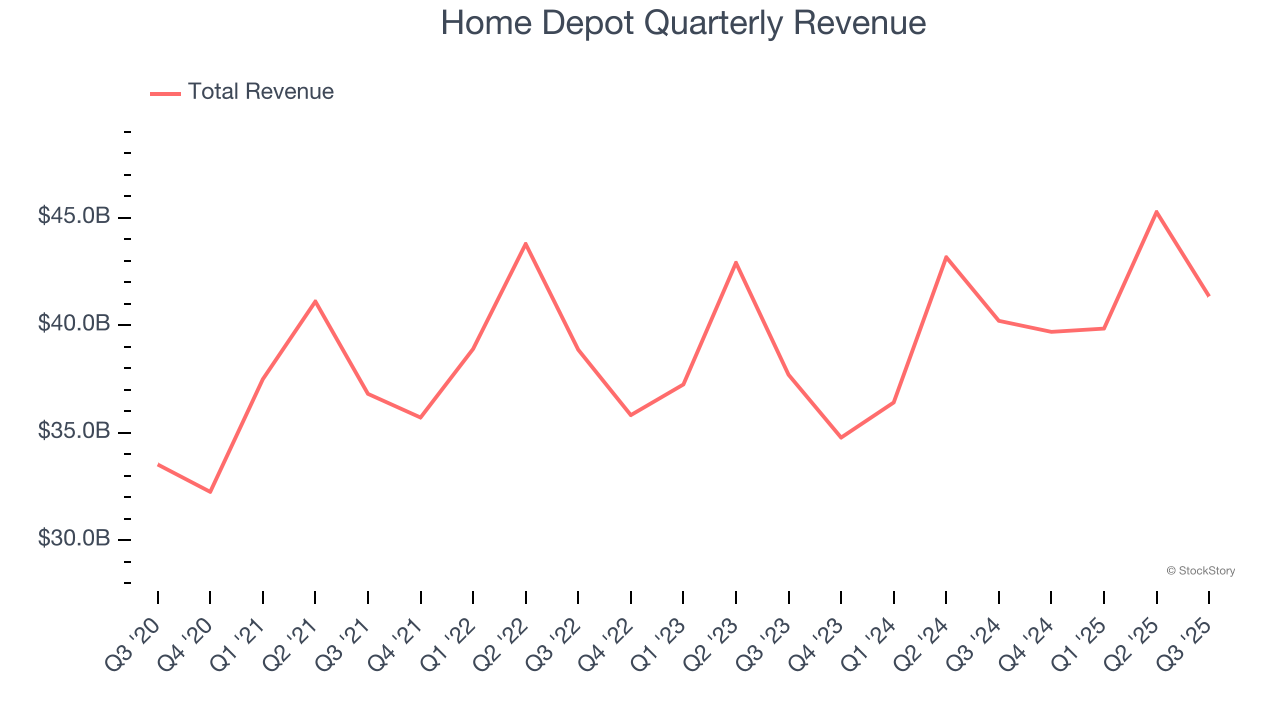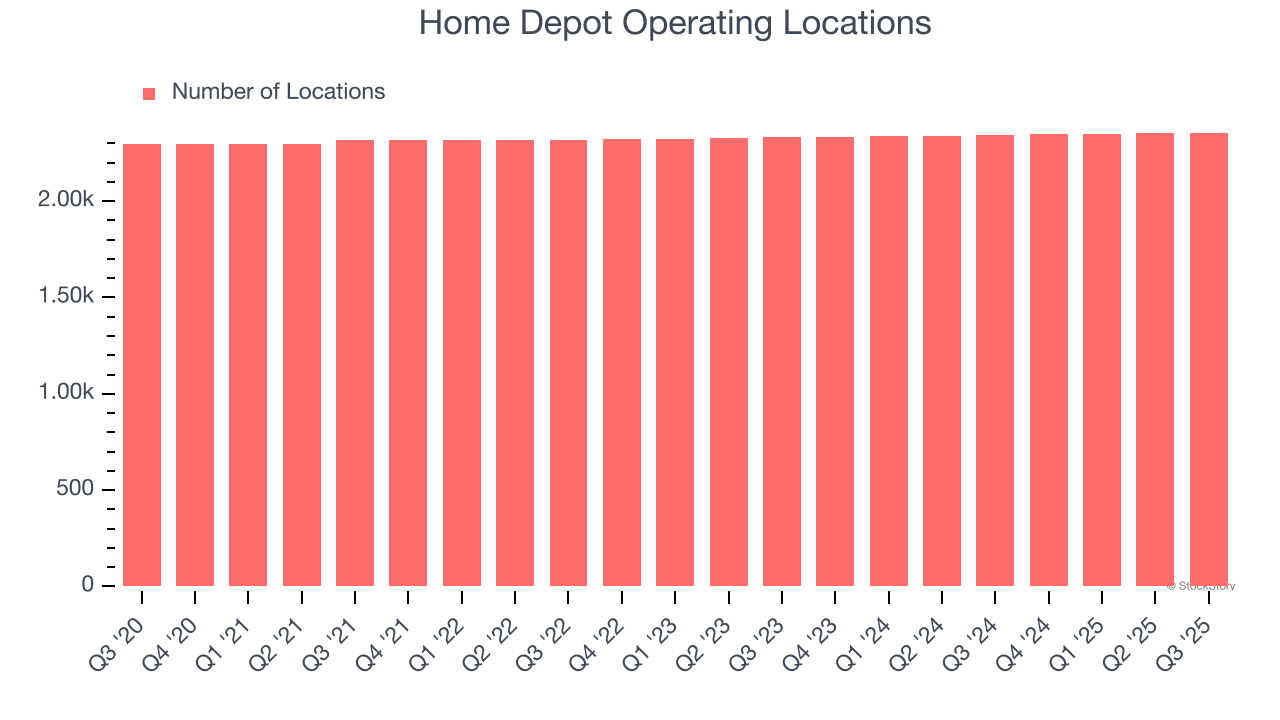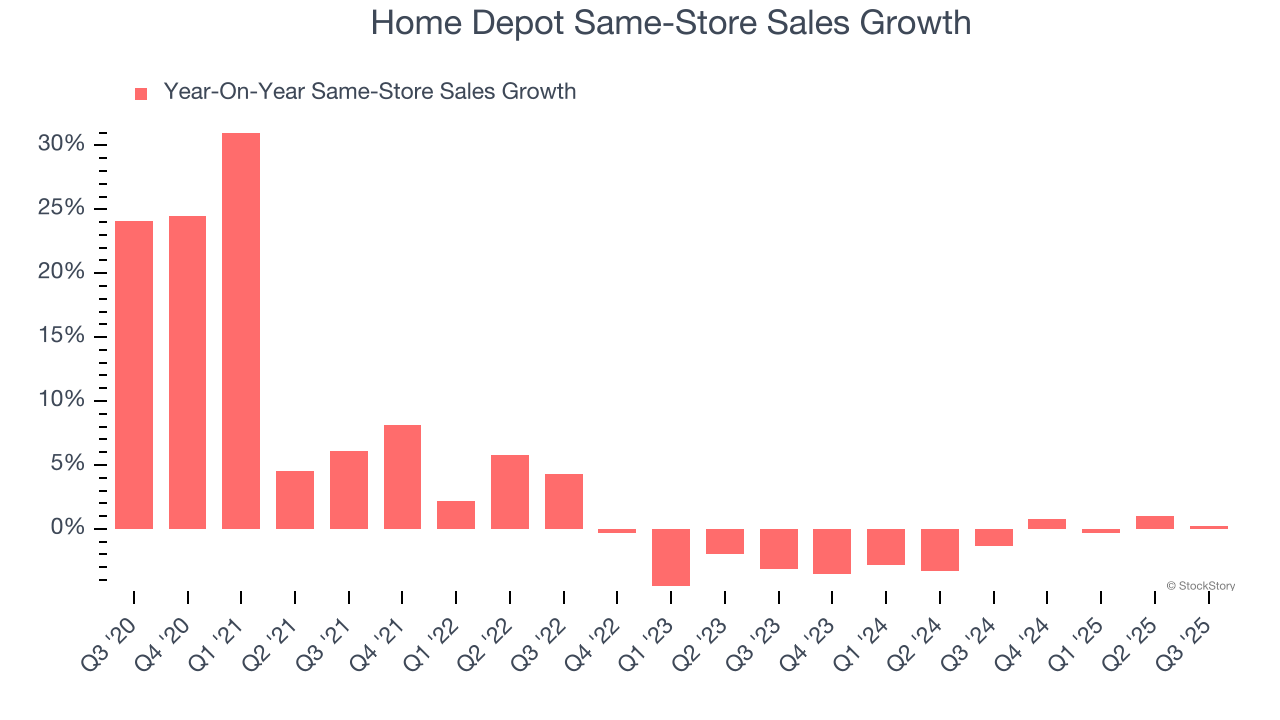
Home improvement retail giant Home Depot (NYSE:HD) met Wall Streets revenue expectations in Q3 CY2025, with sales up 2.8% year on year to $41.35 billion. Its non-GAAP profit of $3.74 per share was 2.5% below analysts’ consensus estimates.
Is now the time to buy Home Depot? Find out by accessing our full research report, it’s free for active Edge members.
Home Depot (HD) Q3 CY2025 Highlights:
- Revenue: $41.35 billion vs analyst estimates of $41.21 billion (2.8% year-on-year growth, in line)
- Adjusted EPS: $3.74 vs analyst expectations of $3.83 (2.5% miss)
- Adjusted EBITDA: $6.18 billion vs analyst estimates of $6.42 billion (14.9% margin, 3.7% miss)
- Operating Margin: 12.9%, in line with the same quarter last year
- Free Cash Flow Margin: 7.5%, similar to the same quarter last year
- Locations: 2,356 at quarter end, up from 2,345 in the same quarter last year
- Same-Store Sales were flat year on year (-1.3% in the same quarter last year)
- Market Capitalization: $356.4 billion
"Our results missed our expectations primarily due to the lack of storms in the third quarter, which resulted in greater than expected pressure in certain categories. Additionally, while underlying demand in the business remained relatively stable sequentially, an expected increase in demand in the third quarter did not materialize. We believe that consumer uncertainty and continued pressure in housing are disproportionately impacting home improvement demand," said Ted Decker, chair, president and CEO.
Company Overview
Founded and headquartered in Atlanta, Georgia, Home Depot (NYSE:HD) is a home improvement retailer that sells everything from tools to building materials to appliances.
Revenue Growth
A company’s long-term sales performance can indicate its overall quality. Any business can put up a good quarter or two, but many enduring ones grow for years.
With $166.2 billion in revenue over the past 12 months, Home Depot is a behemoth in the consumer retail sector and benefits from economies of scale, giving it an edge in distribution. This also enables it to gain more leverage on its fixed costs than smaller competitors and the flexibility to offer lower prices. However, its scale is a double-edged sword because there are only a finite number of places to build new stores, making it harder to find incremental growth. To accelerate sales, Home Depot likely needs to optimize its pricing or lean into international expansion.
As you can see below, Home Depot’s 7% annualized revenue growth over the last six years (we compare to 2019 to normalize for COVID-19 impacts) was tepid as it didn’t open many new stores.

This quarter, Home Depot grew its revenue by 2.8% year on year, and its $41.35 billion of revenue was in line with Wall Street’s estimates.
Looking ahead, sell-side analysts expect revenue to grow 2.6% over the next 12 months, a deceleration versus the last six years. This projection is underwhelming and indicates its products will face some demand challenges.
The 1999 book Gorilla Game predicted Microsoft and Apple would dominate tech before it happened. Its thesis? Identify the platform winners early. Today, enterprise software companies embedding generative AI are becoming the new gorillas. a profitable, fast-growing enterprise software stock that is already riding the automation wave and looking to catch the generative AI next.
Store Performance
Number of Stores
A retailer’s store count often determines how much revenue it can generate.
Home Depot listed 2,356 locations in the latest quarter and has kept its store count flat over the last two years while other consumer retail businesses have opted for growth.
When a retailer keeps its store footprint steady, it usually means demand is stable and it’s focusing on operational efficiency to increase profitability.

Same-Store Sales
The change in a company's store base only tells one side of the story. The other is the performance of its existing locations and e-commerce sales, which informs management teams whether they should expand or downsize their physical footprints. Same-store sales is an industry measure of whether revenue is growing at those existing stores and is driven by customer visits (often called traffic) and the average spending per customer (ticket).
Home Depot’s demand has been shrinking over the last two years as its same-store sales have averaged 1.2% annual declines. This performance isn’t ideal, and we’d be concerned if Home Depot starts opening new stores to artificially boost revenue growth.

In the latest quarter, Home Depot’s year on year same-store sales were flat. This performance was a well-appreciated turnaround from its historical levels, showing the business is improving.
Key Takeaways from Home Depot’s Q3 Results
We struggled to find many positives in these results. Revenue was just in line, with flat same-store sales. This means mature stores did not grow their sales year on year. Additionally, EPS missed. Overall, this quarter could have been better. The stock traded down 2% to $351.63 immediately after reporting.
Home Depot may have had a tough quarter, but does that actually create an opportunity to invest right now? We think that the latest quarter is only one piece of the longer-term business quality puzzle. Quality, when combined with valuation, can help determine if the stock is a buy. We cover that in our actionable full research report which you can read here, it’s free for active Edge members.
